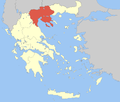Chalkidiki
Chalkidiki
Περιφερειακή ενότητα Χαλκιδικής | |
|---|---|
 Municipalities of Chalkidiki | |
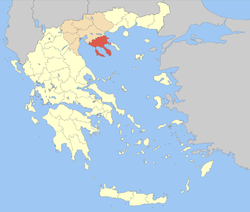 Chalkidiki within Greece | |
| Coordinates: 40°20′N 23°30′E / 40.333°N 23.500°E | |
| Country | Greece |
| Region | Central Macedonia |
| Capital | Polygyros |
| Government | |
| • Vice Governor | Ioannis Giorgos |
| Area | |
| • Total | 2,918 km2 (1,127 sq mi) |
| Population (2011) | |
| • Total | 105,908 |
| • Density | 36/km2 (94/sq mi) |
| Time zone | UTC+2 |
| • Summer (DST) | UTC+3 (EEST) |
| Postal codes | 63x xx |
| Area codes | 237x0, 239x0 |
| ISO 3166 code | GR-64 |
| Car plates | ΧΚ |
| Website | www |
Chalkidiki, also spelt Chalkidike, Chalcidice, Khalkidhiki or Halkidike (Template:Lang-el, [xalciðiˈci]), is a peninsula and regional unit of Greece, part of the Region of Central Macedonia in Northern Greece. The autonomous Mount Athos region constitutes the easternmost part of the peninsula, but not of the regional unit.
The capital of Chalkidiki is the main town of Polygyros, located in the centre of the peninsula. Chalkidiki is a popular summer tourist destination.
Geography

The Cholomontas mountains lie in the north-central part of Chalkidiki. Chalkidiki consists of a large peninsula in the northwestern Aegean Sea, resembling a hand with three "fingers" (though in Greek these peninsulas are often referred to as "legs") – Pallene (now Kassandra), Sithonia, and Agion Oros (the ancient Acte), which contains Mount Athos and its monasteries. Chalkidiki borders on the regional unit of Thessaloniki to the north.
Its largest towns are Nea Moudania (Νέα Μουδανιά), Nea Kallikrateia (Νέα Καλλικράτεια) and the capital town of Polygyros (Πολύγυρος).
There are several summer resorts on the beaches of all three fingers where other minor towns and villages are located, such as at Yerakini (Gerakina Beach), Neos Marmaras (Porto Carras), Ouranoupolis, Nikiti, Psakoudia, Kallithea (Pallene/Pallini, Athos), and more.
Name
Chalcidice (/kælˈkɪdɪki/ or /kælˈsɪdɪsi/), Halkidiki, Chalkidiki, or Chalkidike, is the name given to this peninsula by a group of people native to this region, the Chalcideans (Template:Lang-el), since ancient times.[1][dead link] The area was a colony (apoikia) of the ancient Greek city-state of Chalkis.
History



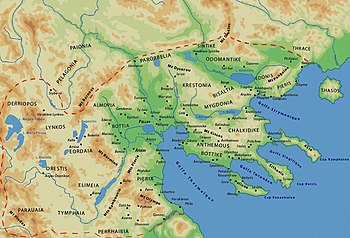
The first Greek settlers in this area came from Chalcis and Eretria, cities in Euboea, around the 8th century BC who founded cities such as Mende,[2] Toroni and Scione[3] a second wave came from Andros in the 6th century BC[4] who founded cities such as Akanthos.[5] The ancient city of Stageira was the birthplace of the great philosopher Aristotle. Chalkidiki was an important theatre of war during the Peloponnesian War between Athens and Sparta. Later, the Greek colonies of the peninsula were conquered by Philip II of Macedon and Chalkidiki became part of Macedonia (ancient kingdom). After the end of the wars between the Macedonians and the Romans, the region became part of the Roman Empire, along with the rest of Greece. At the end of the Roman Republic (in 43 BC) a Roman colony was settled in Cassandreia, which was later (in 30 BC) resettled by Augustus.[6]
During the following centuries, Chalkidiki was part of the Byzantine Empire (East Roman Empire). On a chrysobull of Emperor Basil I, dated 885, the Holy Mountain (Mount Athos) was proclaimed a place of monks, and no laymen or farmers or cattle-breeders were allowed to be settled there. With the support of Nikephoros II Phokas, the Great Lavra monastery was founded soon afterwards. Today, over 2,000 monks from Greece and many other Eastern Orthodox countries, such as Romania, Moldova, Georgia, Bulgaria, Serbia, and Russia, live an ascetic life in Athos, isolated from the rest of the world. Athos with its monasteries has been self-governing ever since.
After a short period of domination by the Latin Kingdom of Thessalonica, the area became again Byzantine until its conquest by the Ottomans in 1430. During the Ottoman period, the peninsula was important for its gold mining. In 1821, the Greek War of Independence started and the Greeks of Chalkidiki revolted under the command of Emmanouel Pappas, a member of Filiki Eteria, and other local fighters. The revolt was progressing slowly and unsystematically. The insurrection was confined to the peninsulas of Mount Athos and Kassandra. One of the main goals was to restrain and detain the coming of the Ottoman army from Istanbul, until the revolution in the south (mainly Peloponnese) became stable. Finally, the revolt resulted in a decisive Ottoman victory at Kassandra. The survivors, among them Papas, were rescued by the Psarian fleet, which took them mainly to Skiathos, Skopelos and Skyros. The Ottomans proceeded in retaliation and many villages were burnt.
Finally, the peninsula was incorporated into the Greek Kingdom in 1912 after the Balkan Wars. In June 2003, at the holiday resort of Porto Carras located in Neos Marmaras, Sithonia, leaders of the European Union presented the first draft of the European Constitution (see History of the European Constitution for developments after this point).
Ancient sites





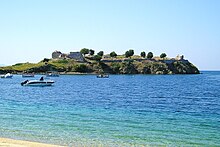

- Acanthus
- Acrothoi
- Aege
- Alapta
- Aphytis
- Apollonia (Chalcidice)
- Charadrus
- Cleonae (Chalcidice)
- Galepsus
- Mekyberna
- Mende
- Neapolis, Chalcidice
- Olophyxus
- Olynthus
- Palaiochori "Neposi" castle
- Polichne
- Potidaea
- Scione
- Scolus
- Sermylia
- Stageira
- Spartolus
- Thyssus
- Torone
- Treasury of the Acanthians
- Xerxes Canal
Economy
Agriculture
The peninsula is notable for its olive oil and olive production. Also various types of wine are produced.
Tourism
Chalkidiki has been a popular summer tourist destination since the late 1950s when people from Thessaloniki started spending their summer holidays in the coastal villages. In the beginning tourists rented rooms in the houses of locals. By the 1960s, tourists from Austria and Germany started to visit Chalkidiki more frequently. Since the start of the big tourist boom in the 1970s, the whole region has been captured by tourism.[7] In the region there is a golf course, with plans for four others in the future.
Mining
Gold was mined in the region during antiquity by Philip II of Macedon and the next rulers. Since 2013, a revival of mining for gold and other minerals was underway with a number of concessions having been granted to Eldorado Gold of Canada. However, critics claim that mining would adversely affect tourism and the environment.[8]
Administration
The regional unit Chalkidiki is subdivided into five municipalities. These are (number as in the map in the infobox):[9]
- Aristotelis (2)
- Kassandra (4)
- Nea Propontida (3)
- Polygyros (1)
- Sithonia (5)
Prefecture
As a part of the 2011 Kallikratis government reform, the regional unit Chalkidiki was created out of the former prefecture Chalkidiki (Template:Lang-el). The prefecture had the same territory as the present regional unit. At the same time, the municipalities were reorganised, according to the table below.[9]
Provinces
- Province of Chalkidiki – Polygyros
- Province of Arnaia
Note: Provinces no longer hold any legal status in Greece.
Television
- TV Halkidiki – Nea Moudania
- Super TV – Nea Moudania
Transport
- Motorways:
- A25 (Thessaloniki, Airport, Nea Moudania)
- Chalkidiki has no railroads or airports.
- A bus system, KTEL, serves major municipalities.
In September 2018 it was announced that Line 2 of the Thessaloniki Metro could be extended in the future in order to serve commuters to and from some areas of Chalkidiki.[10]
Notable inhabitants
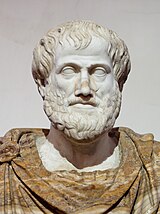
- Paeonius of Mende (late 5th-century BC), sculptor
- Philippus of Mende, Plato's student, astronomer
- Nicomachus, Aristotle's father
- Aristobulus of Cassandreia (375–301 BC), historian, architect
- Aristotle (384 BC in Stageira–322 BC), philosopher
- Andronicus of Olynthus (c. 370 BC), Phrourarchus of Tyre, appointed by Antigonus
- Callisthenes (360–328 BC), historian
- Crates of Olynthus, Alexander's hydraulic engineer
- Bubalus of Cassandreia (304 BC), keles (horse) competing in the flat race of the Lykaia[11]
- Poseidippus of Cassandreia (c. 310 – c. 240 BC), comic poet
- Erginus (son of Simylus) from Cassandreia, citharede winner in Soteria c. 260 BC[12]
- Stamatios Kapsas, revolutionary of the Greek War of Independence (1821–1830)
- Archbishop Demetrios of America
- Xenophon Paionidis (1863–1933), architect
- Manolis Mitsias, singer
- Sokratis Malamas (1957 in Sykia), singer
- Stefanos Athanasiadis, PAOK and Greek footballer.
- Dimitri Vegas & Like Mike, Greek DJs.
- Georgios Samaras, footballer (from his father's, Ioannis Samaras, side)
- Paola Foka, popular Greek folk singer
- Margaritis Schinas, chief spokesperson of the European Commission, and a Deputy Director-General at the Commission's DG Communication
Gallery
-
Petralona cave formations
-
Tombstone in ancient Olynthus
-
Flag of the revolutionaries during the Greek War of Independence
-
Xenia hotel in Paliouri, Chalkidiki (1962)
-
Potidea Kanal
-
Hotel Athos
-
Karvourotripes beach
-
Small island near Nikiti
-
View of Sykia
-
Aerial view of Agios Mamas village (Saint Mammes)
-
Agios Nikolaos village
-
Porto Koufo
-
View of Parthenonas village
-
Gerakini mine exploitation
-
Green olives, product of the region
See also
References
- ^ greekvoyager.com[dead link]
- ^ Thucydides, Book 4, 123
- ^ N. G. L. Hammond, A History of Macedonia, Vol. 1: Historical Geography and Prehistory (Clarendon Press, 1972), p. 426.
- ^ The Cyclades: Discovering the Greek Islands of the Aegean By John Freely p. 82
- ^ Thucydides, Book 4, p. 84
- ^ [1] D. C. Samsaris,The Roman Colony of Cassandreia in Macedonia (Colonia Iulia Augusta Cassandrensis) (in Greek), Dodona 16(1), 1987, 353–437
- ^ Deltsou, Eleftheria (2007). "Second homes and tourism in a Greek village". Ethnologia Europaea: Journal of European Ethnology. 37 (1–2): 124.
- ^ Suzanne Daley (January 13, 2013). "Greece Sees Gold Boom, but at a Price". The New York Times. Retrieved January 14, 2013.
- ^ a b "Kallikratis reform law text" (PDF).
- ^ "ΑΤΤΙΚΟ ΜΕΤΡΟ: «Το Μέτρο στη πόλη μας» με το πρώτο του βαγόνι. Συμμετοχή της Αττικό Μετρό Α.Ε. στην 83η Δ.Ε.Θ." [Attiko Metro: "The Metro in our city" with the first carriage. The participation of Attiko Metro S.A. at the 83rd Thessaloniki International Fair]. www.ametro.gr (in Greek). Retrieved 2018-09-08.
- ^ Arkadia – Lykaion – Epigraphical Database[permanent dead link]
- ^ Phocis – Delphi – Epigraphical Database[permanent dead link]
External links
 Media related to Chalkidiki at Wikimedia Commons
Media related to Chalkidiki at Wikimedia Commons















